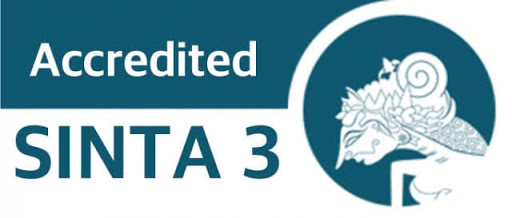THE IMPLEMENTATION OF THE NUMBERED-HEAD-TOGETHER METHOD TO IMPROVE ELEMENTARY SCHOOL STUDENTS’ LEARNING PROCESS
Abstract
This paper discusses the improvement of Class IV students’ learning process at SDN Segeran Kidul Indramayu by applying the Numbered-Head-Together cooperative learning model. The method used is classroom action research (CAR) using Kemmis and Mc. Taggart model for three cycles. The research instruments include student and teacher observation sheets, multiple-choice questions, and documentation. Data analysis includes data collection, data reduction, data presentation, and conclusion. The results of the research imply that there was an improved learning process followed by significant learning outcomes. There was an increased percentage of students’ learning process at 51% in the first cycle. The increased percentage of students’ learning process in the second cycle was 69.38% with a significant percentage of 18.38% from the first cycle. In the third cycle, students fulfilled the learning process indicator of 84.5% with a significant percentage of 15.12% from the second cycle. This significant percentage was reinforced by the pre-test average score of 46.73 smaller than the post-test average score of 62.82 with a completeness percentage of 21.73% in the first cycle. The percentage of students’ learning outcomes in the second cycle was 47.82% with an average value of 72.17. The increased percentage was 26.09% based on the student’s learning outcomes in the first cycle. The percentage of students’ learning outcomes in the third cycle was 82.60% with an average value of 82.39. There was a significant percentage of 34.78% based on the student’s learning outcomes in the second cycle. These results have achieved the school’s minimum criteria of mastery learning indicator (KKM) at 75%. Therefore, the Numbered-Head-Together method is effective and able to increase the elementary school students’ learning process, especially at SDN Segeran Kidul Indramayu.
Keywords
Full Text:
PDF (ENGLISH)References
Aditya, B. R., Jannah, F., & Nurhas, I. (2022). Problem-based numbered head together learning approach for a successful teaching strategy. JINoP (Jurnal Inovasi Pembelajaran), 8(1), 84–94.
Aka, K. A. (2016). Model Quantum Teaching dengan Pendekatan Cooperative Learning untuk Meningkatkan Kualitas Pembelajaran PKn. Jurnal Pedagogia, 5(1), 35–46.
Amri, S. (2013). Pengembangan dan Model Pembelajaran dalam Kurikulum 2013. PT. Prestasi Pustakarya.
Anggari, A. (2015). Tema 3 Peduli Terhadap Makhluk Hidup. Balitbang Kemendikbud.
Azwar, S. (2011). Reliabilitas dan Validitas. Pustaka Pelajar.
Baskoro, R. A. (2020). The Comparison of Numbered Head Together Learning Models and Think Pair Share in terms of Elementary School Mathematics Learning Outcomes. International Journal of Elementary Education, 4(4), 550–557.
Bloom, B. S. (1956). Taxonomy of Educational Objectives : The Classification of Educational Goals, Handbook I Cognitive Domain. Longmans, Green and Co.
Depdikbud. (1997). Manual Item and Test Analysis. Depdikbud: Pusat Penelitian dan Pengembangan Sistem Pengujian.
Fathurrohman and Sutikno. (2017). Strategi Belajar Mengajar melalui Penanaman Konsep Umum & Konsep Islam. PT. Refika Aditama.
Isjoni. (2016). Cooperative Learning. CV. Alfabeta.
Masitoh dan Dewi. (2009). Strategi Pembelajaran. Departemen Agama RI.
Nurgiyantoro, B. (2004). Statistik terapan untuk Penelitian Ilmu-Ilmu Sosial. Gajah Mada University Press.
Prayekti, H., Haryadi, & Utomo, U. (2019). The Effect of Numbered Heads Together (NHT) Model Assisted with Audio Visual Media On The Learning Outcomes of Identifying Story Elements of Students Grade V. Journal of Primary Education, 8(2), 232–237.
Presiden. (2005). Undang-Undang Republik Indonesia Nomor 14 Tahun 2005 tentang Guru dan Dosen. Presiden Republik Indonesia.
Rusman. (2012). Model–Model Pembelajaran Mengembangkan Profesionalisme Guru. PT. Raja Grafindo Persada.
Sani, R. A. (2019). Strategi Belajar Mengajar. PT. Raja Grafindo Persada.
Sanjaya, W. (2015). Penelitian Tindakan kelas. Prenadamedia Group.
Sari, A. Y. (2020). Improving Civics Learning Outcomes Through Numbered Heads Together Class II Elementary School Learning Model. Social, Humanities, and Education Studies (SHEs): Conference Series, 3(4), 19–25.
Shoimin, A. (2014). 68 Model Pembelajaran Inovatif dalam Kurikulum 2013. Ar-Ruzz Media.
Solikhin, F. , S. W. I. , D. K. (2021). The Application of Numbered Heads Together (NHT) in Online Learning. International Journal of Chemistry Education Research, 5(2), 84–90.
Sudikin. (2010). Manajemen Penelitian Tindakan Kelas. Insan Cendekia.
Sugiyono. (2016). Metode Penelitian Pendidikan: Pendekatan Kuantitatif, Kualitatif, dan R&D. CV. Alfabeta.
Widyastuti, R. (2021). Mathematical problem-solving ability: The effect of numbered head together (NHT) model and mathematical prior knowledge. Journal of Advanced Sciences and Mathematics Education, 1(2), 73–78.
Wilanda, T. F., & Iman, J. N. (2017). The Use of Numbered Head Together (NHT) Technique with Descriptive Text to Improve the Tenth Grade Students Reading Comprehension of SMA Muhammadiyah 1 Palembang. Global Expert Jurnal Bahasa Dan Sastra, 6(1), 13–18.
DOI: http://dx.doi.org/10.33578/pjr.v7i2.9164
Refbacks
- There are currently no refbacks.
Copyright (c) 2023 JURNAL PAJAR (Pendidikan dan Pengajaran)

This work is licensed under a Creative Commons Attribution-NonCommercial-ShareAlike 4.0 International License.
JURNAL PAJAR (Pendidikan dan Pengajaran)
Secretariat
Program Studi Pendidikan Guru Sekolah Dasar
Gedung B1, FKIP Universitas Riau
Kampus Bina Widya Km. 12,5 Simpang Baru Panam
Pekanbaru Riau Indonesia 28293
e-mail : pajar@ejournal.unri.ac.id



